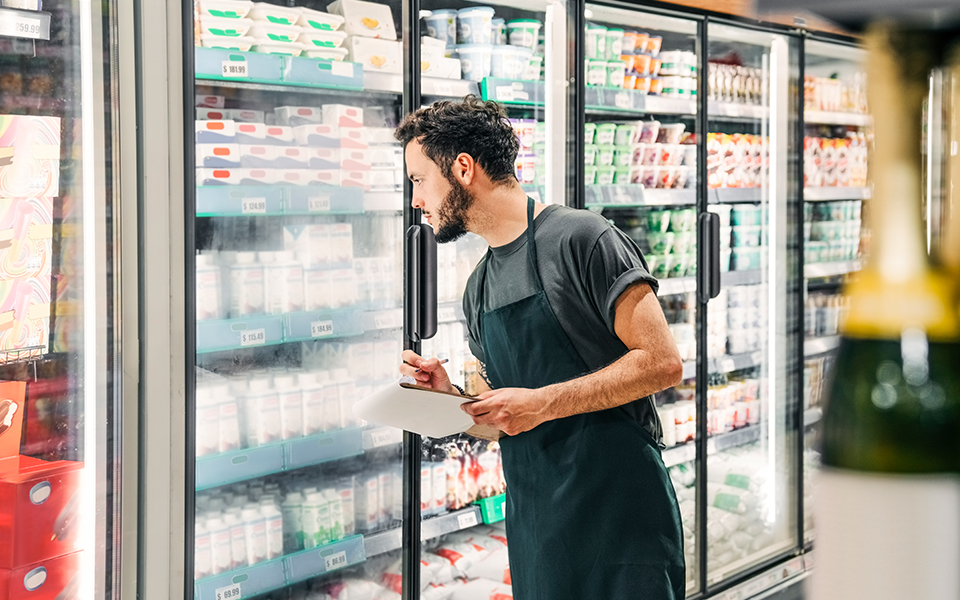*On June 1, 2023 Emerson’s Climate Technologies business became a new standalone company – Copeland. Though our name has changed, we are building on more than a century of HVACR innovation and industry leadership, and Copeland continues to offer the same products, industry stewardship, and learning opportunities you’ve grown to trust. Information found on this webpage posted before June 1, 2023 may contain our old name or branding, but you can be at ease knowing it was created with the knowledge and expertise of Copeland.
In the first blog in this series, we discussed the many distinguishing properties of CO2 (or refrigerant R-744) — including its high system pressures, low critical point and triple point. These characteristics introduce a multitude of unique servicing considerations that differ significantly from traditional hydrofluorocarbon (HFC)-based systems. In this installment, we’ll review some key tips that technicians need to be aware of when servicing CO2 transcritical booster systems. You can also learn more about a variety of related CO2 topics in our new CO2 Chats video series.

From a refrigerant storage best practices perspective, R-744 tank storage is similar to standard HFC storage, including stacking procedures, safety precautions and keeping them chained off in a designated storage area. But that’s where the similarities end. Because CO2 tanks are designed to handle its high pressures, they weigh significantly more than standard HFC bottles. Empty CO2 tanks can weigh close to 150 lbs.; when loaded with 50 lbs. of refrigerant, each cylinder can potentially weigh nearly 200 lbs.
Many supermarkets prefer to have an entire system charge on hand, which could potentially be up to 2,000 lbs. Storing that would require 40 cylinders totaling a weight of 8,000 lbs. — or 4 tons. It’s important for contractors to understand where to store the reserve refrigerant and if it will affect building codes by having that much CO2 in one space. And if stored on a mezzanine, it must be capable of handling the total storage weight.
How do you charge a CO2 refrigeration system?
When charging a CO2 refrigeration system, the most important consideration a technician should keep in mind is the triple point pressure of CO2. 60.4 psi is the pressure at which CO2 will turn to dry ice. As a result, contractors must be careful not to charge with liquid CO2 when the system is below this pressure, and instead charge with vapor until the system reaches triple point. Failure to do so will result in the formation of dry ice. There are various anecdotes about technicians — who are more familiar with charging HFC systems — charging a CO2 system with liquid and causing the formation of dry ice.
Begin charging by introducing CO2 vapor into the system, and then build system pressure to 60.4 psi and beyond based on equipment manufacturer recommendations — up to 145 lbs. Then, it will be safe to switch to liquid CO2 to finish charging the system quickly and effectively without the risk of dry ice formation.
What is trapped liquid in a CO2 refrigeration system?
CO2’s coefficient of expansion (COE) is higher than a typical HFC refrigerant. One potential scenario that can occur in a CO2 system is when liquid refrigerant gets trapped in between two valves. In this instance, the pressure can increase 145 psi for every 1.8 °F increase in temperature. As a result, some systems may need to be fitted with appropriate pressure relief valves at the location of the trapped liquid to assist with system operation and service.
How do you detect leaks in CO2 systems?
Since there is an abundance of CO2 already present in the atmosphere, R-744 refrigerant can be difficult to detect and requires the use of a capable leak detection system. CO2 is colorless, odorless and heavier than air, requiring leak detectors to be mounted 18 inches off the ground and below the breathing level. Like HFC systems, it’s important to immediately detect and mitigate CO2 leaks as they occur.
Manufacturers such as Emerson have designed CO2-specific leak detection technology that quickly can sense the presence of higher levels of carbon dioxide in a machine room or a walk-in box. Emerson offers both a stand-alone CO2 leak detection solution as well as devices that can be seamlessly integrated into a building management system (BMS), such as the Lumity™ supervisory control platform.
Are there safety issues to be aware of when handling CO2 refrigerant?
Because CO2 refrigeration systems operate at extremely high pressures, technicians should take precautions when handling CO2. Even when the system is shut off, standstill pressures are extremely high and need to be handled carefully. In addition, CO2 can displace oxygen and release it in excessive amounts because it’s heavier than air. As a result, technicians should avoid handling it in confined spaces. But with proper training and equipment design, CO2 can be used safely.
For more information on CO2 servicing tips and best practices, please view the companion topic in our CO2 Chats video series. The next installment of the CO2 Refrigeration Fundamentals blog series will focus on system operation. To learn more about Emerson’s comprehensive CO2 products and capabilities, please visit Climate.Emerson.com/CO2Solutions.

Facility Health Score Insights Program Transforms Enterprise Maintenance
Leveraging refrigeration performance data drives food retail cost reductions. Maintaining proper...

Electrical component considerations for A2L system safety
Electrical component considerations for A2L system safety As a new refrigerant category in the...

A2L refrigerant regulation updates: what you need to know today
Preparing for the approval and safe use of A2Ls in commercial refrigeration applications The move...
